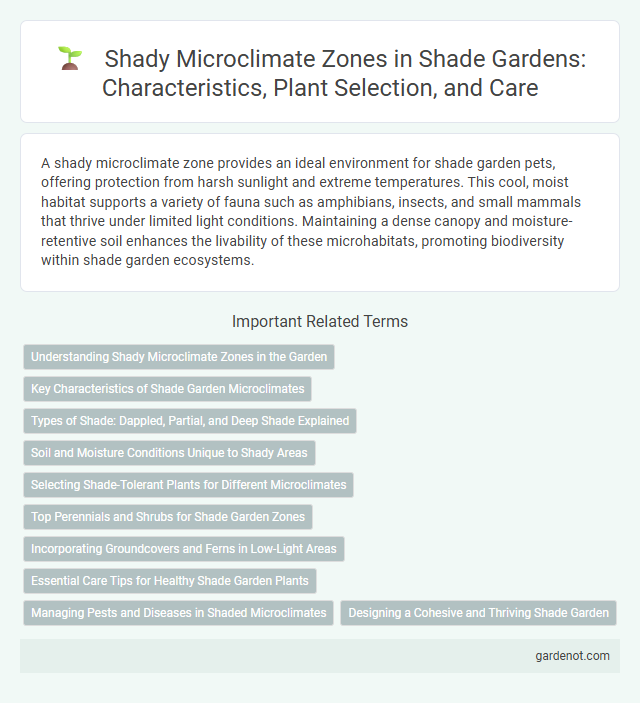A shady microclimate zone provides an ideal environment for shade garden pets, offering protection from harsh sunlight and extreme temperatures. This cool, moist habitat supports a variety of fauna such as amphibians, insects, and small mammals that thrive under limited light conditions. Maintaining a dense canopy and moisture-retentive soil enhances the livability of these microhabitats, promoting biodiversity within shade garden ecosystems.
Understanding Shady Microclimate Zones in the Garden
Shady microclimate zones in gardens are areas that receive limited direct sunlight, typically under dense tree canopies or beside buildings, creating cooler, more humid conditions. Plants in these zones must be shade-tolerant and adapted to lower light levels, such as hostas, ferns, and astilbes, which thrive in dappled or indirect sunlight. Understanding soil moisture retention and temperature variations in these microclimates helps gardeners select appropriate species and improve plant health in shade gardens.
Key Characteristics of Shade Garden Microclimates
Shade garden microclimates feature lower light levels, higher humidity, and cooler temperatures compared to sun-exposed areas. These zones often have dense canopy cover from trees or shrubs, reducing direct sunlight and creating dappled shade patterns. Soil in shade microclimates tends to retain moisture longer, supporting shade-tolerant plants like ferns, hostas, and impatiens.
Types of Shade: Dappled, Partial, and Deep Shade Explained
Dappled shade occurs under trees with light, filtered sunlight creating a gentle, patchy light pattern ideal for ferns and hostas. Partial shade provides a balance of sunlight and shadow, typically receiving 3-6 hours of direct sun, favoring plants like astilbes and bleeding hearts. Deep shade exists in areas blocked from most sunlight, perfect for mosses and shade-tolerant groundcovers that thrive in cool, dim environments.
Soil and Moisture Conditions Unique to Shady Areas
Shady microclimate zones often feature soil with higher organic matter due to slower decomposition rates under limited sunlight, resulting in richer nutrient retention. Moisture conditions in these areas remain consistently damp because reduced evaporation rates help retain water, creating an ideal environment for shade-loving plants. Soil in shady gardens tends to be cooler and more acidic, influencing the types of vegetation that thrive in these unique moisture and soil conditions.
Selecting Shade-Tolerant Plants for Different Microclimates
Shade-tolerant plants thrive in shady microclimate zones characterized by limited sunlight and cooler temperatures, making them ideal for dense tree canopies or north-facing garden areas. Selecting species such as hostas, ferns, and astilbes ensures adaptability to varying moisture levels and soil conditions typical of shaded environments. Incorporating native shade-loving plants enhances biodiversity while maintaining a resilient and visually appealing shade garden.
Top Perennials and Shrubs for Shade Garden Zones
Top perennials such as hostas, ferns, and astilbes thrive in shady microclimate zones, providing lush foliage and vibrant seasonal blooms that enrich shade garden aesthetics. Shade-tolerant shrubs like hydrangeas, azaleas, and rhododendrons offer structure and color, enhancing layered planting designs in low-light areas. Selecting plants with proven shade resilience ensures robust growth and sustained garden health in shaded environments.
Incorporating Groundcovers and Ferns in Low-Light Areas
In shady microclimate zones, incorporating groundcovers and ferns enhances soil moisture retention and prevents erosion by forming dense, low-growing layers that thrive in low-light conditions. Shade-tolerant groundcovers like Pachysandra and Vinca minor provide evergreen foliage year-round, while diverse ferns such as Japanese Painted Fern and Lady Fern add texture and depth to the understory. These plants improve biodiversity, support beneficial insects, and create a lush, resilient ground layer essential for maintaining a healthy shade garden ecosystem.
Essential Care Tips for Healthy Shade Garden Plants
Shade garden plants thrive in shady microclimate zones by requiring consistent moisture and well-draining soil rich in organic matter. Regular mulching helps retain soil moisture and suppress weeds, while avoiding excessive fertilization prevents nutrient imbalances that can stress shade-loving species. Monitoring for pests like slugs and fungal diseases is crucial to maintaining healthy foliage and promoting vigorous growth in low-light conditions.
Managing Pests and Diseases in Shaded Microclimates
Shaded microclimates create unique conditions that often increase humidity and reduce airflow, fostering environments where pests such as aphids, spider mites, and fungal diseases thrive. Effective management includes improving air circulation through selective pruning, using shade-tolerant, disease-resistant plants, and applying organic treatments like neem oil or insecticidal soap to control infestations. Monitoring soil moisture levels is crucial to prevent root rot and fungal growth typical in damp, low-light areas of shade gardens.
Designing a Cohesive and Thriving Shade Garden
Selecting shade-tolerant plants such as hostas, ferns, and astilbes ensures robust growth in a shady microclimate zone by adapting to low light and higher moisture levels. Incorporating layered planting techniques with ground covers, mid-height shrubs, and taller trees enhances biodiversity and creates a visually cohesive shade garden. Implementing rich organic mulch and well-draining soil improves moisture retention and nutrient availability, promoting a thriving garden ecosystem in shaded areas.
Shady microclimate zone Infographic

 gardenot.com
gardenot.com